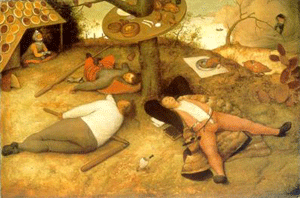In the early Middle Ages the Languedoc was not part of France. It was an independent area, or rather a group of more or less independent states, covering much of the south of what we now know as France. It had its own language, Occitan, which gave the area its name - The word Languedoc derives from langue d'oc - a language in which the word for "yes" was "oc". It also had its own rulers - the greatest of which were the Counts of Toulouse. It was a major commercial crossroads, the land of the troubadours, where learning was widespread, where minorities were tolerated and new ideas welcomed.
All this ended when the area was annexed to France after a long war (the infamous Crusade against the Cathars in the Thirteenth century. French Kings and, in more recent times French Presidents, have tried to eliminate the areas traditional identity as part of a programme of building a French state. So it was that Occitan was suppressed, lands were seized and the City of Toulouse was detached administratively from much of its heartland.
To the South of the Languedoc, the Roussillon was also
an independent state as was its sister state, the County
of Barcelona. The Counts of Barcelona later
became Kings of Aragon and Catalonia, both of which straddled
the the Pyrenees
( Pirenčus,
Pirenčus,
 Pirineus,
Pirineus,
 Pyrénées).
In 1258 a treaty between Louis XI of France and Jacob I,
confirmed the Roussillon as Aragonese territory.
For a while part of the Kingdom of Aragon was set up as
a separate state, known as the Kingdom of Majorca.
Perpignan became the capital of this Kingdom in 1262.
Pyrénées).
In 1258 a treaty between Louis XI of France and Jacob I,
confirmed the Roussillon as Aragonese territory.
For a while part of the Kingdom of Aragon was set up as
a separate state, known as the Kingdom of Majorca.
Perpignan became the capital of this Kingdom in 1262.
In 1475 Perpignan fell into the hands of Louis XI after a long siege, but it was soon back under Araganese control. In 1495, Castillia and Aragon combined to form the kingdom of Spain. Ferdinand (the Catholic) of Aragon and Isabella of Castille made their entry in Perpignan, bringing the Spanish Inquisition with them. After a period of misery, plague and religious persecution, another siege of Perpignan under Louis XIII in 1642 brought the city under French control. (Under the Treaty of the Pyrenees in 1659 the Roussillon was ceded to the French, though culturally it continues to be Catalan to this day. The Catalan language is still widely spoken. The modern Languedoc has been partnered with the Roussillon The Languedoc-Rousillon is now one of 22 Régions of France, with the Roussillon reincarnated as the Pyrénées Orientales, one of the five Département within it.)
The Land of Cocaigne
|
For over three-hundred years, from the 14th to the 16th century a plant called the "pastello" (Isatis tinctoria) was responsible for the economic fortunes of a famous triangle lying between Toulouse, Carcassonne and Albi. Imported from Asia in from the 12th century, pastel was grown here from 1463. It was used to colour clothes blue, and was exported through Bayonne and after 1520 along the Garonne river. The leaves of the pastello plant were pulverized and then kneaded into a ball called the còca. the pulverized leaves were kneaded with urine to produce cocanha. A concentrate, agranat, was extracted which generated a dark blue dye, destined for major cloth producers in the markets of Northern Europe. Up to 60,000 tons of dye (granato) were produced a year. This trade in pastello, regulated and controlled in all its productive stages by merchant corporations, generated great wealth for Toulouse and its surroundings. The region became one of the most prosperous of the time, to such an extent that the term "Land of cocanha" came to mean a mythical place, of immense wealth (it was easily corrupted into the "Land of Cacaigne" which makes more sense to modern ears. It was during this period that the great monuments of Toulouse were erected, under the direction of the capitouls. So too the impressive town houses of centres such as Albi. The spread of Protestantism in the region also dates to the same time, thanks to the close links made with Northern Europe. The pastel mills promoted the circulation of the bible, which at least partially explains the widespread conversion of people to Protestantism in the surrounding areas (such as Montauban, Castres, and Revel). After 1560, Indigo (imported from the Americas) started to compete with pastel, signaling the end of the Land of Cocaine. |
|







